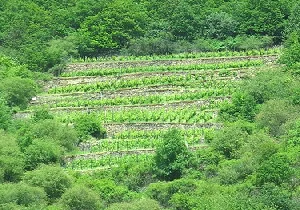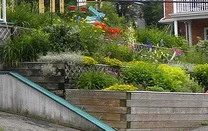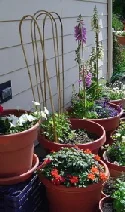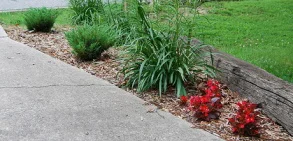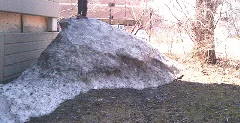Microclimates
A microclimate is the climate of a specific small area that is different than that of the larger climate or growing zone. Microclimates in your own landscape can dramatically affect the performance of your plants.
As gardeners we are working with microclimates all the time weather we realize it or not. Sometimes it is just that gardening sense telling us to protect certain plants from cold north winds or make sure it is open to breezes to help protect mildew. And plant care recommendations that we try to follow are often based on microclimate information. Recognizing that these microclimates exist is important, but understanding what creates the microclimate takes some careful assessment of all areas of your property. Evaluating these microclimates in our landscape is difficult because there are so many variables. But the more we understand about the mini climate conditions through our landscapes and gardens, the more success we will have with our plants.
In general you will find that the north side of your home is cold, shaded and damp. The south side is warm, sunny, and dries quickly. The east side is a moderate zone in most respects. And the west side is cool in the morning but can get very hot in the afternoon. But there is so much more to know before you select plants.
Understanding microclimates will not only help you select plants that will thrive by providing ideal growing conditions, but it may allow you to successfully grow plants out of your growing zone. Certain microclimates may create conditions that are much milder than normal in your growing zone. Under the right conditions you may be able to grow marginally hardy plants for your zone.
To understand microclimates you need to know what physical conditions in your landscape alter the climate conditions of the landscape as a whole. A list of the conditions that create changes to the greater climate is the simplest way to demonstrate, but keep in mind that combinations of conditions can change the climate more dramatically one way or another, and that one condition may “cancel out” another.
Low spots in your landscape are frost prone. Cold air is heavier than warm air and tends to settle deeply in a low spot.
Low spots collect high levels of moisture from rain runoff and tend to remain wet for long periods.
Cold air is heavy and flows to low spots. If you plant on a slope the cold air that creates frost may flow around and past your plants without being able to drop the temperature around your plants enough to damage them.
A raised bed will warm up and dry out quickly in spring, especially with a southern exposure.
Cold air, and therefore frost, may settle in hillside terraces if there is no outlet for the cold air to exit. Hardier plants may be necessary. A gap in the terrace wall will allow the cold air to exit and flow out, since it will seek the lowest spot possible.
High ground allows greater exposure to breezes, ideal for mildew prone plants that need good air circulation.
High ground dries out quickly due to rain runoff and exposure to winds.
Areas that are exposed to sun all day are warmest and will be the last areas to freeze in winter and the first areas to thaw in spring.
The north sides of a structure, wall or hedge will receive no sun in winter and be assaulted by cold north winds, combining to create a very cold and drying environment for plants.
The south and east side of a structure are sheltered from northwest winds, creating a warmer environment.
Afternoon sun is much hotter than morning sun.
Areas shaded from afternoon sun will thaw and warm up very slowly in spring. These cold zones will start growth late and remain cooler all season.
Overhead shelter such as a tree or deck can trap heat, keeping the area warmer as temperatures fall overnight.
Plants exposed to late afternoon sun in summer may be heat stressed. In early and late winter the warm sun can warm the plants such as evergreens up enough to disturb dormancy, then temperatures drop below freezing quickly overnight, stressing the plant.
Plants on the east side of a structure are protected from warmer afternoon sun in summer and winter.
Wind can reduce frost threat by keeping the air circulating.
Wind can reduce snow accumulation in winter, leaving less protection through winter.
Snow is an excellent insulator for plants. It moderates the soil temperature preventing deep freezing, and prevents rapid freeze and thaw cycles that can heave plants out of the ground.
Buildings and solid structures can accelerate wind velocity. As wind hits the structure it races along the wall and when it hits the corner, the wind rushes around the corner. Now you have cold drying winds on two, if not three areas of the structure.
Heated structures such as your house absorb heat all day and radiate it back out at night. The south and east sides will remain warmer over night along the structure if winds are from the northwest.
Decks, balconies and rooftops are high enough to avoid early and late frosts that settle to the ground, but may be more exposed to cold or drying winds in winter and extreme temperatures in summer.
Spring flowering bulbs planted close to a heated building foundation may not get cold enough in winter to complete their chilling process, which is essential for blooming.
Fences, walls and boulders can create two microclimates. On one side a sheltered area may be created that remains warm. On the other, cold air may settle creating a frost pocket. These conditions vary depending on the orientation and slope.
Solid walls and fences create a windbreak on one side but turbulence on the other as the wind hits the wall and races to the end and blasts out the side.
Hedges and openwork fences can moderate winds on one side while minimizing turbulence on the other.
Concrete driveways and sidewalks absorb heat in the day and radiate the heat at night. The immediately surrounding area may have a more moderated temperature.
Concrete driveways and sidewalks, and especially blacktop can create very hot conditions on summer days along the edge.
Hard impervious surfaces including driveways, sidewalks, patios and roofs, can create wet areas from water runoff.
Trees with dense crowns not only create shade, but dry areas. It is difficult for rain to penetrate a dense leaf cover, and the tree itself will likely draw a lot of water out of the soil.
Shade from any large plant or structure creates a cool area.
Shade from structures can also create wet areas since the area may take longer to dry out.
Soil that is high in organic matter is slow to freeze and to thaw, preventing the plant from heaving and beginning spring growth too early.
Densely planted areas provide insulation for the soil, moderating soil temperatures.
Ponds and small bodies of water absorb heat and radiate it back slowly to the immediately surrounding area. A small body of water will have a minimal effect, but the deeper the water the greater the effect.
Clay soil temperature is the most stable, moderating slowly.
Sandy soil is subject to the greatest temperature fluctuations.
Soil that is heavily mulched is slow to freeze and to thaw, preventing the plant from heaving and beginning spring growth too early.
Acidic soil can be created by constant needle drop of conifers. The affect on pH is not dramatic, but can be enough to aid the growing of acid loving plants.
Far corners of a large property may not receive supplemental watering from sprinklers simply because of the distance from the water spout. These areas will generally be dry and require drought tolerant plants.
Boulevards and often large margins along the street may be heavily dosed with salt and chemicals in the winter. The salt content of the soil is likely very high and will require salt tolerant plants.
Some microclimates are larger than others.
Areas along large bodies of water may have quite a different climate than the greater region further from the water, often tending to be more moderate overall. The water absorbs heat and radiates it back slowly.
But of course we have all heard of “lake effect snow” too.
A valley may be cool and moist compared to the general growing region surrounding it because heavier cold air will flow into the valley.
Hilly terrain causes clouds to form over them. Without getting into the lengthy details, the windward side of the hill may tend to be moist and the leeward side dry. This seems contradictory to common sense, and in fact the many variables of hilly terrain can change the result.
Hilltops are exposed to drying winter winds that can scald plants, especially evergreens.
Slopes in hilly areas are slow to warm up on the north face and warm quickly on the south face.
Urban areas absorb a good deal of heat in buildings and pavement and radiate that warmth back to the air in the evening, so they tend to be warmer in winter, but they can also be significantly warmer in summer too.
Urban areas absorb the summer heat as well as reducing air flow and breezes because of all the buildings. This is often referred to as an urban heat island.
Tall buildings in urban areas can also create very strong winds by channeling wind to ground level and tunneling it through streets. You may also notice wind tunnels on certain streets through your neighborhood and where roads are cut through forests or large stands of trees.
Take a little time to survey your property and evaluate possible microclimates. You may need to observe and pay close attention over a period of time to thoroughly understand all the different climate zones right on your own property. This is a lot of information to take in all at once, but it will help you to select appropriate plants for each area of your landscape.
